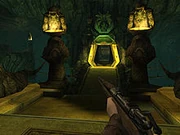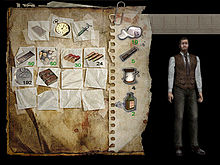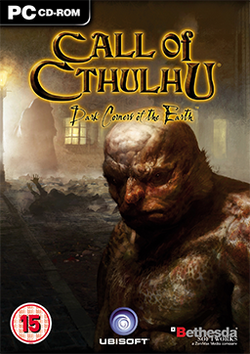is a Lovecraftian horror first-person action-adventure game developed by Headfirst Productions and published by The game is based on the works of H. P. Lovecraft, author of The Call of Cthulhu and progenitor of the Cthulhu Mythos. It is a re-imagining of Lovecraft's novella "The Shadow over Innsmouth", also containing elements from the Call of Cthulhu role-playing game campaign "Escape from Innsmouth". Although the story diverges in several places and features a different protagonist, several levels in the game mirror passages from the novella. A major sub-plot of the game is also inspired by Lovecraft's novella The Shadow Out of Time. At least two and possibly three additional Cthulhu Mythos games were planned by Headfirst Productions, including the direct sequel to Dark Corners titled Call of Cthulhu: Destiny's End. However, due to the bankruptcy and liquidation of Headfirst in 2006, these games were effectively canceled
Plot[]
On September 6, 1915, Detective Jack Walters is called to investigate a decrepit manor house located in Boston, Massachusetts. The manor is inhabited by a small cult called the Fellowship of the Yith, led by one Victor Holt. Taking cover from an ensuing firefight, Jack finds himself separated from the police and trapped inside the mansion, with no option but to investigate. When the rest of the police finally break in, they find the cultists dead by mass suicide and Walters apparently insane. He is committed to Arkham Asylum, where he stays for several years.
More than six years later, Walters is released and returns to life as a private detective. He takes up a missing person case at Innsmouth, a strange and xenophobic coastal town. After asking the rude locals about the disappearance of Brian Burnham, he stays a night at the local hotel, where he barely escapes an attempt to murder him. From that point forward, he is forced to sneak through the town, avoiding the murderous patrols of the townsfolk. He meets undercover agent Lucas Mackey, who tells him that the town is under government investigation.
Cthulhu Mythos elements[]
Persons
Zadok Allen provides the protagonist with a detailed recent history of the town, but is killed and thrown to the sewers to be fed to a Shoggoth. Obed Marsh's descendants play a large and prominent role in the story. A few fictional members of the Waite family ("The Thing on the Doorstep") are part of the story. One of the jailhouse inmates, Henry, complains of rats in the walls, as taken from Lovecraft's short story The Rats in the Walls. A direct reference to the short story The Whisperer in Darkness can be seen in the first level, where a cultist is found bound to a surgical table, his organs dissected from his body, yet still functioning in containers attached by tubes to his body. Although not related to the Mythos, the character of Agent Mackey has a notable physical resemblance to H.P. Lovecraft himself.
Literature
The game is a combined retelling of The Shadow Over Innsmouth and The Shadow Out of Time, with the latter used as a framing device for the former. The Greek copy of the Pnakotic Manuscripts, known as the Pnakotica, appears in the game. On a shelf in the protagonist's office, a copy of Unaussprechlichen Kulten and the Book of Eibon can be seen. Most of the texts are directly tied to Dagon, such as his Book, Oaths, Tablets, and prayers."The Music of Erich Zann" is alluded to in a newspaper clipping.
Entities
The Great Race of Yith plays a major role in the plot, even though they are not physically present except for the very beginning and end of the game. The Deep Ones and their related half-human citizens of Innsmouth are central to the plot and comprise the main opposition to the player throughout most of the game. Father Dagon and Mother Hydra are the game's bosses. The Innsmouth sewer system hints at the presence of a Shoggoth through numerous human remains and strange residue that is highly-corrosive to organic material. The creature itself is confronted directly during the refinery raid. The flying polyps are encountered in an ancient chasm near the end of the game, and are the subject of a dream that Jack Walters has while drifting to Devil's Reef. A star-spawn of Cthulhu appears as an enemy. While not present, the Mi-go are mentioned in passing during the epilogue. Despite the title, Cthulhu himself does not appear, though statues in his likeness can be found as well as documents about him. In one room, Cthulhu exerts a cosmic influence through his statue: if Jack does not escape the room quickly enough, he is driven insane and kills himself.The Elder Things are mentioned in a sermon found upon a podium during the prologue level.
Gameplay[]
The game features no HUD interface. The player character's condition is relayed through the sound cues of his heartbeat and breathing, which become more pronounced when wounded, and colour draining from the screen with loss of blood and strength. Specific injuries are also indicated visually and aurally. For example, a broken leg causes Jack to limp while making appropriate noises, and a broken arm makes aiming more difficult. The health system was designed as a more realistic take on character injury than other games of its genre in that different

wounds and injuries require different remedies, such as a splint for a broken leg. Jack loses sanity when he looks directly at upsetting aspects of the game world, such as mutilated bodies or precipitous drops, similar to the Nintendo Gamecube game Eternal Darkness: Sanity's Requiem. Sanity loss can lead to hallucinations and visions, which manifest as graphical anomalies, sound distortion, and changes in

control sensitivity. Jack also begins to suffer from schizophrenia, hearing voices from various sources, such as his inner child pleading for him to go back to darker personalities. If he becomes too unsettled, permanent insanity or suicide causes a Game Over. Initially, the gameplay mostly comprises unarmed escape and evasion, together with investigative exploration, although weapons and combat are introduced later on. As with most survival horror action/adventure games, ammunition is limited and must be conserved carefully for situations when it will really be indispensable, occasionally requiring the player to avoid combat even when armed. The game as a whole is heavily scripted and very linear, with only one path through the chapters from start to finish, in contrast with some earlier survival horror games such as the original Alone in the Dark (which is also based on the Mythos). The areas marked with the Elder Signs serve as sanctuaries against the enemies and as save points. Most of the weapons in the game have real-life counterparts, including a Smith & Wesson M1917, a Colt 1911, a double-barreled shotgun, an M1903 Springfield, and an M1921 Thompson. The only exception is a Yithian directed-energy weapon. The game does not have an artificial on-screen targeting reticle. Instead, the player must aim through the iron sights on the weapons themselves. Sustained aiming tires the character and drops accuracy. The player character can melee attack with a gun if all ammunition for it has been used up. The shooting system is unique in that fired rounds go exactly where the barrel is pointing. For example, if the player readies a weapon and pulls the trigger before the character animation has finished, the round may fly towards the sky if that's where the barrel was pointing when the shot was fired. The game contains a number of bugs, which have never been officially patched. For example, during one mission the player needs to fire a cannon at enemy wizards. On some Windows systems, the enemies are not rendered by the game at all, making it very difficult for the player to hit them. There is an unofficial patch available that fixes some bugs and lowers the game's overall difficulty level. The bugs are generally intermittent, and restoring from an earlier saved game can be enough to get past them.
Development[]
The game has been in development for at least six years, and the development can be traced back to August 1999 and this Usenet discussion where the Mythos fans contributed ideas for the game to Headfirst's artist designer Andrew Brazier. This and other feedback was later used to create the game. The first screenshots were shown in December 1999, and the game, originally planned for the PC and PlayStation 2, was scheduled for release in the third quarter of 2001. Before E3 2001 the game was stated to be "70 percent complete", but it ended up being repeatedly delayed. In late 2002 the game's original publisher Fishtank Interactive was taken over by JoWood, which had no interest in the title. The developers then signed a deal with Bethesda to release the game for the PC and Xbox, and the development of the PS2 version was canceled. Headfirst Productions originally intended for a much larger, non-linear RPG-type storyline to be fitted within the game, including more characters and locations, as well as a co-op system for up to four players, which would have enabled players to pick one of four characters and carry out their own investigation independently or team up with the others. A multiplayer version of the game would have allowed for online deathmatch battles in specifically designed levels. A lot of other features, such as high environment interactivity, were also scrapped due to budget and time constraints and problems with the level design. Player weapons originally conceived but ultimately removed from the game include a wooden club with a nail protruding from one end, a wooden police baton, a meat cleaver (the cleaver can still be seen in the Gilman hotel, however, Jack refuses to touch it as it is covered in blood), a fishing harpoon, a tomahawk axe, a metal bar (the bar survived to be used as an item in the game), a poison-tipped Deep One spear, dynamite sticks, hand grenades, a flamethrower (which does appear as a non-acquirable weapon in the final game), a Luger P-08 pistol, a Mauser C96 broom handle pistol (removed because it was too similar to the two handguns that made it into the game), a single-barrel Winchester Model 1912 12-gauge pump action shotgun (some enemies carry this shotgun, but the player cannot use it), a 4" Colt Python .357 Magnum revolver, and a stationary M2 Browning machine gun (it is seen in the Marsh Refinery level but cannot be used). The Springfield rifle was originally going to be equipped with a scope and bayonet. Headfirst initially used the game engine NDL NetImmerse for rendering graphics combined with the Havok physics engine but later developed its own engine. The game's protagonist Jack Walters went through up to eight different phases before a final look was designed by Tim Appleton. The title was eventually released in October 2005 for Xbox and in March 2006 for the PC.
Reception[]
The game was generally well received, including outright praise by some. On Metacritic, the PC version of the game has an average critic score of 76/100 ("Generally favorable reviews"), with 9 positive and 8 mixed reviews. GameRankings averages the review scores of the Xbox version to 78%. It was one of the five games nominated by GameSpot for the title of Most Surprisingly Good Game of 2005, with a comment: "After a development cycle that was nearing infinity, it's hard to imagine a world where this H.P. Lovecraft-based horror game turned out all right. Luckily for us, we don't have to imagine it. In 2010, 1UP.com featured it on the list of Top 5 Game Worlds Where Insanity Is The Entire Point. In 2011, PC Gamer ranked it as 87th on the list of the 100 best PC games of all time.
